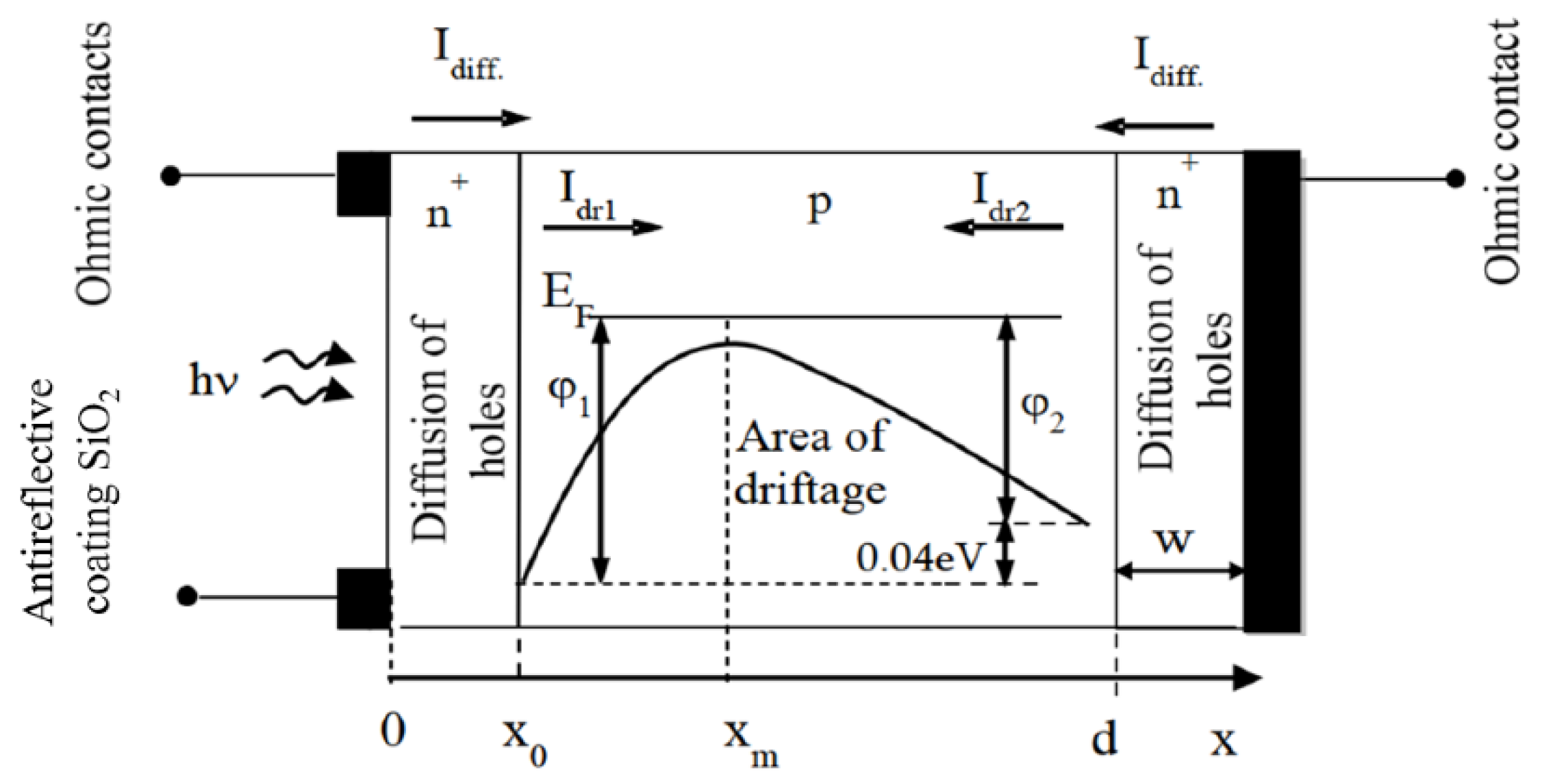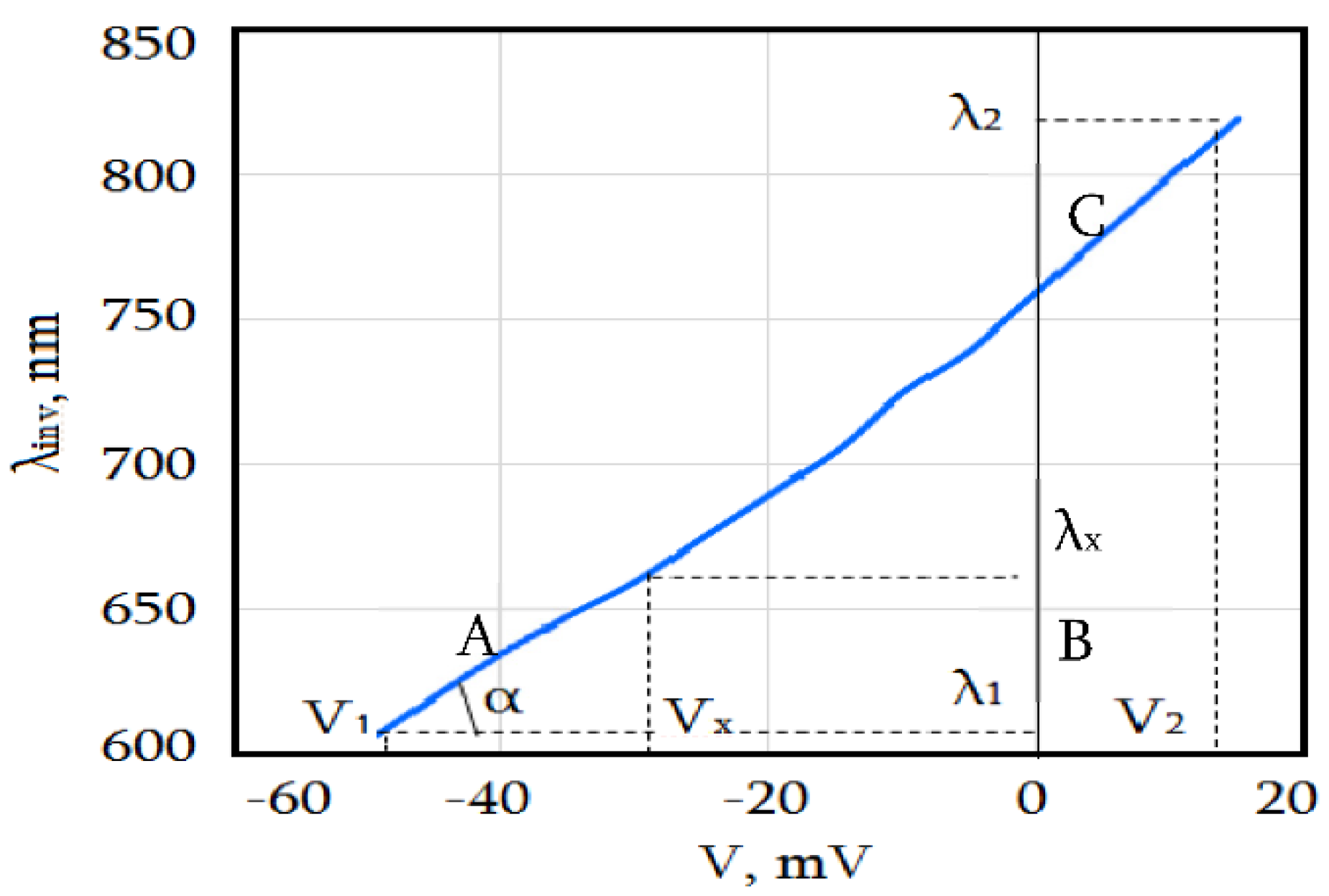On the Selective Spectral Sensitivity of Oppositely Placed Double-Barrier Structures
Abstract
:1. Introduction
2. Structure and Experiment
3. Results and Discussion
- When the voltages were positive, the near-surface barrier was reverse-biased and the rear barrier was forward-biased. When the polarity changed, the opposite effect was observed. Since the near-surface barrier was 0.04 eV higher than the rear barrier (see Figure 1), the photocurrent was determined by the near-surface barrier and remained negative within the wavelength range of 350–600 nm when the bias voltage changed from positive to negative up to −0.04 V;
- With the increase in the wavelength, the influence of the reverse photocurrent of the rear barrier gradually increased, and the total photocurrent passing through the short-wave maximum (in the wavelength region of 490 nm) dropped, since, due to the exponential absorption law, the quanta fell deeper and the generated photocurrent of the rear junction began to counteract the photocurrent of the near-surface barrier;
- At a wavelength of 600 nm, the rear photocurrent became commensurable with the surface photocurrent. The maximum compensation of the opposed photocurrents occurred, which was determined by the minimum value of the absolute photocurrent. Within the wavelength range of 600–1000 nm, with an increase in the wavelength, the photocurrent that was mainly determined by the rear barrier increased in the absolute value and, in the region of the intrinsic absorption of silicon, formed a long-wave maximum, which, at high negative voltages, was in the wavelength region of 830 nm. With the decrease in the voltage in the absolute value, the maximum shifted towards the long waves and reached the wavelength region of 880 nm. Here, a certain role was assumed by the rear out-of-the-base region, which was wide enough to ensure the diffusion current of the rear junction and the effective absorption of the deeply penetrated long waves;
- At the positive biases, the near-surface barrier was reverse-biased, and with the decrease in the voltage, the long-wave maximum (830 nm) shifted towards the short waves (730 nm) since the height of the near-surface barrier decreased, and the influence of its photocurrent preserved the advantage only when the waves were shorter (i.e., with the decrease in the absorption depth).
4. Conclusions
Author Contributions
Funding
Institutional Review Board Statement
Informed Consent Statement
Data Availability Statement
Conflicts of Interest
References
- Worsfold, P.; Zagatto, E. Spectrophotometry-Overview. In Encyclopedia of Analytical Science, 3rd ed.; Worsfold, P., Poole, C., Townshend, A., Miró, M., Eds.; Academic Press: Oxford, UK, 2019; pp. 244–248. [Google Scholar]
- Thomas, O.; Burgees, C. UV-Visible Spectrophotometry of Water and Wastewater, 2nd ed.; Elsevier Science: London, UK, 2017; p. 2. [Google Scholar]
- Global Spectrophotometer Market 2020–2024. Available online: https://www.researchandmarkets.com/reports/5157122/global-spectrophotometer-market-2020-2024 (accessed on 24 June 2022).
- Albert, D.R.; Todt, M.A.; Davis, H.F. A Low-Cost Quantitative Absorption Spectrophotometer. J. Chem. Educ. 2012, 89, 1432–1435. [Google Scholar] [CrossRef]
- Bui, D.A.; Hauser, P.C. Analytical Devices based on Light-emitting Diodes-a Review of the State-of-the-Art. Anal. Chim. Acta 2015, 853, 46–58. [Google Scholar] [CrossRef] [PubMed]
- Fang, Y.; Armin, A.; Meredith, P.; Huang, J. Accurate Characterization of Next-Generation Thin-Film Photodetectors. Nat. Photonics 2019, 13, 1–4. [Google Scholar] [CrossRef]
- Zhang, T.; Wang, F.; Zhang, P.; Wang, Y.; Chen, H.; Li, J.; Wu, J.; Chen, L.; Chen, Z.D.; Li, S. Low-temperature Processed Inorganic Perovskites for Flexible Detectors with a Broadband Photoresponse. Nanoscale 2019, 11, 2871–2877. [Google Scholar] [CrossRef] [PubMed]
- Xu, Y.; Lin, Q. Photodetectors Based on Solution-processable Semiconductors: Recent Advances and Perspectives. Appl. Phys. Rev. 2020, 7, 011315. [Google Scholar] [CrossRef]
- Huo, N.; Konstantatos, G. Recent Progress and Future Prospects of 2D-Based Photodetectors. Adv. Mater. 2018, 30, 1801164. [Google Scholar] [CrossRef] [PubMed]
- Wu, Y.; Li, X.; Wei, Y.; Gu, Y.; Zeng, H. Perovskite Photodetectors with Both Visible-Infrared Dual-Mode Response and Super-Narrowband Characteristics towards Photo-Communication Encryption Application. Nanoscale 2018, 10, 359–365. [Google Scholar] [CrossRef] [PubMed]
- Liu, D.; Zhou, W.; Ma, Z. Semiconductor Nanomembrane-Based Light-Emitting and Photodetecting Devices. Photonics 2016, 3, 40. [Google Scholar] [CrossRef] [Green Version]
- Sun, Z.; Chang, H. Graphene and Graphene-like Two-Dimensional Materials in Photodetection: Mechanisms and Methodology. ACS Nano 2014, 8, 4133–4156. [Google Scholar] [CrossRef] [PubMed]
- Elif, Ç.S.; David, S.F.; Mutlu, G.; Ekmel, Ö.; Mesut, S.; Selim, M.; Ünlü, M.S. Improved selectivity from a wavelength addressable device for wireless stimulation of neural tissue. Front. Neuroeng. 2014, 7, 5. [Google Scholar] [CrossRef] [Green Version]
- Yin, J.; Tan, Z.; Hong, H.; Wu, J.; Yuan, H.; Liu, Y.; Chen, C.; Tan, C.; Yao, F.; Li, T.; et al. Ultrafast and Highly Sensitive Infrared Photodetectors based on Two-dimensional Oxyselenide Crystals. Nat. Commun. 2018, 9, 3311–3320. [Google Scholar] [CrossRef] [PubMed]
- Hu, X.; Liu, H.; Wang, X.; Zhang, X.; Shan, Z.; Zheng, W.; Li, H.; Wang, X.; Zhu, X.; Jiang, Y.; et al. Wavelength Selective Photodetectors Integrated on a Single Composition-Graded Semiconductor Nanowire. Adv. Opt. Mater. 2018, 6, 1800293. [Google Scholar] [CrossRef]
- Zhang, Z.; von Wenckstern, H.; Schmidt, M.; Grundmann, M. Wavelength Selective Metal-Semiconductor-Metal Photodetectors based on (Mg, Zn) O-heterostructures. Appl. Phys. Lett. 2011, 99, 083502. [Google Scholar] [CrossRef]
- Wang, Z.; Yi, S.; Chen, A.; Zhou, M.; Luk, T.S.; James, A.; Nogan, J.; Ross, W.; Joe, G.; Shahsafi, A.; et al. Single-shot on-chip Spectral Sensors based on Photonic Crystal Slabs. Nat. Commun. 2019, 10, 1020. [Google Scholar] [CrossRef] [PubMed]
- Chen, B.; Chen, Y.; Deng, Z. Recent Advances in High Speed Photodetectors for eSWIR/MWIR/LWIR Applications. Photonics 2021, 8, 14. [Google Scholar] [CrossRef]
- Gergel, V.A.; Lependin, A.V.; Tishin, Y.I.; Vanyushin, I.V.; Zimoglyad, V.A. Boron Distribution Profiling in Asymmetrical n+ -p Silicon Photodiodes and New Creation Concept of Selectively Sensitive Photoelements for Megapixel Color Photoreceivers. In Micro-and Nanoelectronics 2005; SPIE: Bellingham, WA, USA, 2006; Volume 6260. [Google Scholar]
- Khudaverdyan, S.; Tsaturyan, S.; Vaseashta, A. Selective Sensitivity Sensor for Explosive Detection and Identification. In Meeting Security Challenges through Data Analytics and Decision Support; IOS Press: Amsterdam, The Netherlands, 2016; pp. 99–107. [Google Scholar] [CrossRef]
- Khudaverdyan, S.; Vaseashta, A.; Khachatryan, M.; Lapkis, M.; Rudenko, S. New Method of Optical Spectroscopy for Environmental Protection and Safety. In Functional Nanostructures and Sensors for CBRN Defence and Environmental Safety and Security; Springer: Berlin/Heidelberg, Germany, 2020; pp. 271–281. [Google Scholar] [CrossRef]
- Khudaverdyan, S.; Vaseashta, A.; Ayvazyan, G.; Khachatryan, M.; Atvars, A.; Lapkis, M.; Rudenko, S. On the Semiconductor Spectroscopy for Identification of Emergent Contaminants in Transparent Mediums. In Advanced Sciences and Technologies for Security Applications; Springer Nature: Cham, Switzerland, 2021; pp. 663–689. [Google Scholar] [CrossRef]
- Green, M.A. Self-consistent Optical Parameters of Intrinsic Silicon at 300K Including Temperature Coefficients. Sol. Energy Mat. Sol. Cells 2008, 92, 1305–1310. [Google Scholar] [CrossRef]
- Sze, S.M. Physics of Semiconductor Devices, 2nd ed.; John Wiley and Sons: New York, NY, USA, 1981. [Google Scholar]








Publisher’s Note: MDPI stays neutral with regard to jurisdictional claims in published maps and institutional affiliations. |
© 2022 by the authors. Licensee MDPI, Basel, Switzerland. This article is an open access article distributed under the terms and conditions of the Creative Commons Attribution (CC BY) license (https://creativecommons.org/licenses/by/4.0/).
Share and Cite
Khudaverdyan, S.; Vaseashta, A.; Ayvazyan, G.; Matevosyan, L.; Khudaverdyan, A.; Khachatryan, M.; Makaryan, E. On the Selective Spectral Sensitivity of Oppositely Placed Double-Barrier Structures. Photonics 2022, 9, 558. https://doi.org/10.3390/photonics9080558
Khudaverdyan S, Vaseashta A, Ayvazyan G, Matevosyan L, Khudaverdyan A, Khachatryan M, Makaryan E. On the Selective Spectral Sensitivity of Oppositely Placed Double-Barrier Structures. Photonics. 2022; 9(8):558. https://doi.org/10.3390/photonics9080558
Chicago/Turabian StyleKhudaverdyan, Surik, Ashok Vaseashta, Gagik Ayvazyan, Ler Matevosyan, Ashot Khudaverdyan, Mane Khachatryan, and Elya Makaryan. 2022. "On the Selective Spectral Sensitivity of Oppositely Placed Double-Barrier Structures" Photonics 9, no. 8: 558. https://doi.org/10.3390/photonics9080558
APA StyleKhudaverdyan, S., Vaseashta, A., Ayvazyan, G., Matevosyan, L., Khudaverdyan, A., Khachatryan, M., & Makaryan, E. (2022). On the Selective Spectral Sensitivity of Oppositely Placed Double-Barrier Structures. Photonics, 9(8), 558. https://doi.org/10.3390/photonics9080558





